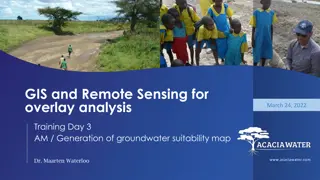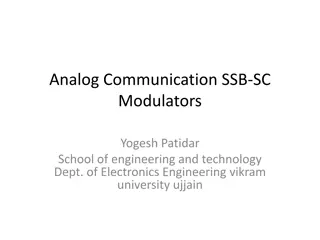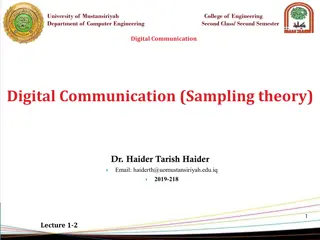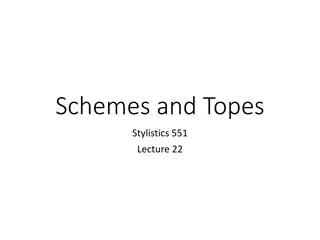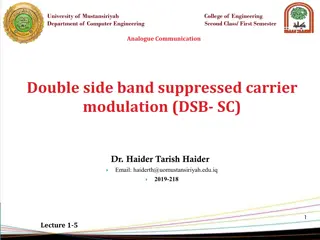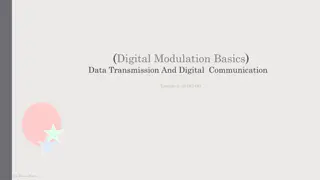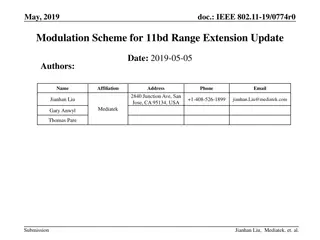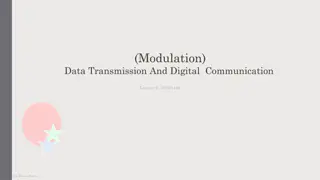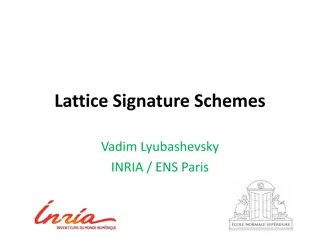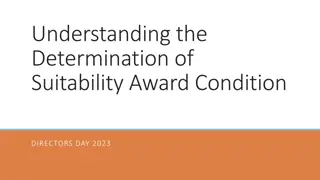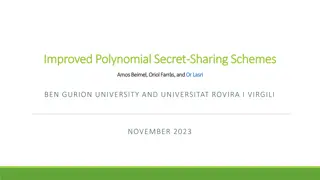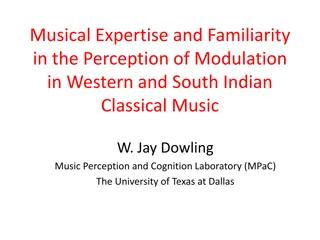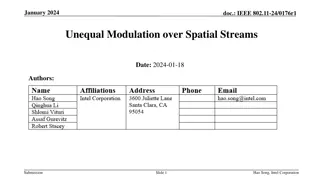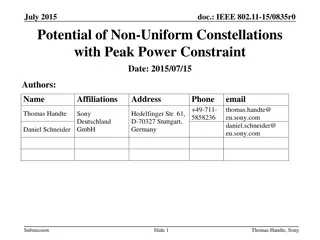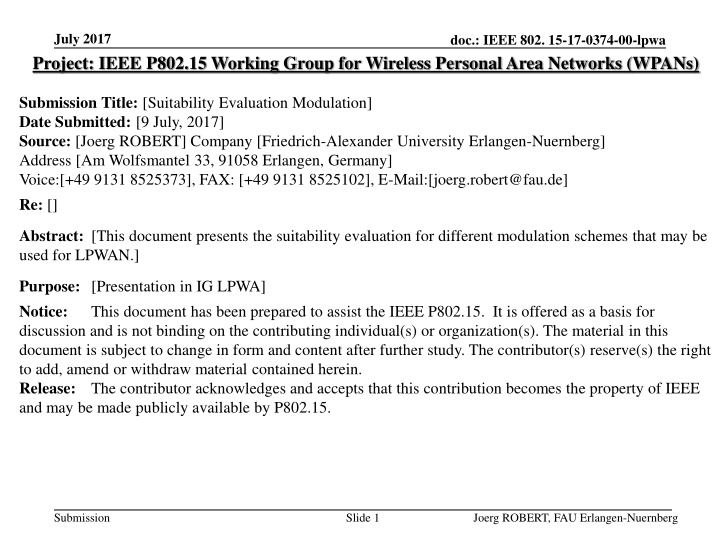
Evaluation of Modulation Schemes for LPWAN in Wireless Networks
Explore the suitability of modulation schemes for Low-Power Wide Area Networks (LPWAN) in wireless personal area networks. This document provides an in-depth analysis of different modulation techniques, including OFDM and CDMA, considering factors like robustness, bandwidth efficiency, interference, and power consumption.
Download Presentation

Please find below an Image/Link to download the presentation.
The content on the website is provided AS IS for your information and personal use only. It may not be sold, licensed, or shared on other websites without obtaining consent from the author. If you encounter any issues during the download, it is possible that the publisher has removed the file from their server.
You are allowed to download the files provided on this website for personal or commercial use, subject to the condition that they are used lawfully. All files are the property of their respective owners.
The content on the website is provided AS IS for your information and personal use only. It may not be sold, licensed, or shared on other websites without obtaining consent from the author.
E N D
Presentation Transcript
July 2017 Project: IEEE P802.15 Working Group for Wireless Personal Area Networks (WPANs) doc.: IEEE 802. 15-17-0374-00-lpwa Submission Title: [Suitability Evaluation Modulation] Date Submitted: [9 July, 2017] Source: [Joerg ROBERT] Company [Friedrich-Alexander University Erlangen-Nuernberg] Address [Am Wolfsmantel 33, 91058 Erlangen, Germany] Voice:[+49 9131 8525373], FAX: [+49 9131 8525102], E-Mail:[joerg.robert@fau.de] Re: [] Abstract: [This document presents the suitability evaluation for different modulation schemes that may be used for LPWAN.] Purpose: [Presentation in IG LPWA] Notice: This document has been prepared to assist the IEEE P802.15. It is offered as a basis for discussion and is not binding on the contributing individual(s) or organization(s). The material in this document is subject to change in form and content after further study. The contributor(s) reserve(s) the right to add, amend or withdraw material contained herein. Release: The contributor acknowledges and accepts that this contribution becomes the property of IEEE and may be made publicly available by P802.15. Submission Slide 1 Joerg ROBERT, FAU Erlangen-Nuernberg
July 2017 doc.: IEEE 802. 15-17-0374-00-lpwa Suitability Evaluation of Modulation Schemes Joerg Robert, FAU Erlangen- Nuernberg Submission Slide 2 Joerg Robert, FAU Erlangen-Nuernberg
July 2017 doc.: IEEE 802. 15-17-0374-00-lpwa OFDM ( I / II ) OFDM (Orthogonal Frequency Division Multiplexing) splits the data into multiple parallel sub-carriers Robustness wrt. multi-path not required for narrow- band applications Pros Robust wrt. multi-path Well defined bandwidth Robust wrt. narrow-band interference Simple support of powerful FEC Cons High PAPR (peak to average power ratio ) power in-efficient transmitter Sensitive wrt. Doppler shifts (mobility) Requires FEC Sensitive wrt. short interferers Submission
July 2017 doc.: IEEE 802. 15-17-0374-00-lpwa OFDM ( II / II ) Channel Model Indoor Outdoor Rural Outdoor Urban Interference Model Dense Medium Low None Active Interfering Users Very High High Medium Low Frequency Regulation ETSI FCC ETSI/FCC None LP-WAN Localization <10m <100m None Power Supply CR 2025 2xAA Energy Harvesting External Cell Radius > 50km < 50km < 10km < 5km < 1km Node Velocity 3 km/h 30 km/h 120 km/h Submission Slide 4 Joerg Robert, FAU Erlangen-Nuernberg
July 2017 doc.: IEEE 802. 15-17-0374-00-lpwa CDMA ( I / II ) CDMA (Code Division Multiple Access) spreads the data using orthogonal sequences Pros Simple generation High bandwidth precise localization Robust wrt. fading Gain wrt. interference Cons Requires power control for effective use (not possible in typical LP-WAN) Highly increased bandwidth more sensitive wrt. strong interference Submission
July 2017 doc.: IEEE 802. 15-17-0374-00-lpwa CDMA ( II / II ) Channel Model Indoor Outdoor Rural Outdoor Urban Interference Model Dense Medium Low None Active Interfering Users Very High High Medium Low Frequency Regulation ETSI FCC ETSI/FCC None LP-WAN Localization <10m <100m None Power Supply CR 2025 2xAA Energy Harvesting External Cell Radius > 50km < 50km < 10km < 5km < 1km Node Velocity 3 km/h 30 km/h 120 km/h Submission Slide 6 Joerg Robert, FAU Erlangen-Nuernberg
July 2017 doc.: IEEE 802. 15-17-0374-00-lpwa DSSS ( I / II ) DSSS (Direct Sequence Spread Spectrum) spreads the data using defines sequences (similar to CDMA without orthogonal codes) Pros Simple generation High bandwidth precise localization Robust wrt. fading Gain wrt. interference Cons Highly increased bandwidth more sensitive wrt. strong interference Less users than CDMA Submission
July 2017 doc.: IEEE 802. 15-17-0374-00-lpwa DSSS ( II / II ) Channel Model Indoor Outdoor Rural Outdoor Urban Interference Model Dense Medium Low None Active Interfering Users Very High High Medium Low Frequency Regulation ETSI FCC ETSI/FCC None LP-WAN Localization <10m <100m None Power Supply CR 2025 2xAA Energy Harvesting External Cell Radius > 50km < 50km < 10km < 5km < 1km Node Velocity 3 km/h 30 km/h 120 km/h Submission Slide 8 Joerg Robert, FAU Erlangen-Nuernberg
July 2017 doc.: IEEE 802. 15-17-0374-00-lpwa FCSS ( I / II ) FCSS (Frequency Chirp Spread Spectrum) spreads the data using frequency chirps (typically frequency ramp) Pros Simple generation Robust wrt. fading Gain wrt. interference Cons Highly increased bandwidth more sensitive wrt. strong interference Only few quasi orthogonal frequency ramps few parallel users Submission
July 2017 doc.: IEEE 802. 15-17-0374-00-lpwa FCSS ( II / II ) Channel Model Indoor Outdoor Rural Outdoor Urban Interference Model Dense Medium Low None Active Interfering Users Very High High Medium Low Frequency Regulation ETSI FCC ETSI/FCC None LP-WAN Localization <10m <100m None Power Supply CR 2025 2xAA Energy Harvesting External Cell Radius > 50km < 50km < 10km < 5km < 1km Node Velocity 3 km/h 30 km/h 120 km/h Submission Slide 10 Joerg Robert, FAU Erlangen-Nuernberg
July 2017 doc.: IEEE 802. 15-17-0374-00-lpwa FHSS ( I / II ) FHSS (Frequency Hopping Spread Spectrum) spreads narrow-band signals onto different frequencies using frequency hopping Pros Simple generation Robust wrt. fading Gain wrt. interference Cons Complex receiver Requires FEC Submission
July 2017 doc.: IEEE 802. 15-17-0374-00-lpwa FCSS ( II / II ) Channel Model Indoor Outdoor Rural Outdoor Urban Interference Model Dense Medium Low None Active Interfering Users Very High High Medium Low Frequency Regulation ETSI FCC ETSI/FCC None LP-WAN Localization <10m <100m None Power Supply CR 2025 2xAA Energy Harvesting External Cell Radius > 50km < 50km < 10km < 5km < 1km Node Velocity 3 km/h 30 km/h 120 km/h Submission Slide 12 Joerg Robert, FAU Erlangen-Nuernberg
July 2017 doc.: IEEE 802. 15-17-0374-00-lpwa FHSS ( I / II ) FHSS (Frequency Hopping Spread Spectrum) spreads narrow-band signals onto different frequencies using frequency hopping Used in addition to narrow-band modulation Pros Simple generation Robust wrt. fading Gain wrt. interference Cons Complex receiver Requires FEC Submission
July 2017 doc.: IEEE 802. 15-17-0374-00-lpwa FHSS ( II / II ) Channel Model Indoor Outdoor Rural Outdoor Urban Interference Model Dense Medium Low None Active Interfering Users Very High High Medium Low Frequency Regulation ETSI FCC ETSI/FCC None LP-WAN Localization <10m <100m None Power Supply CR 2025 2xAA Energy Harvesting External Cell Radius > 50km < 50km < 10km < 5km < 1km Node Velocity 3 km/h 30 km/h 120 km/h Submission Slide 14 Joerg Robert, FAU Erlangen-Nuernberg
July 2017 doc.: IEEE 802. 15-17-0374-00-lpwa Non-coherent Narrow-Band Modulation ( I / II ) Use of narrow-band modulation (e.g. FSK, MSK, ...) with non-coherent decoding Pros Simple generation Cons Performance loss wrt. coherent receiver Does not meet FCC for low rates due to 0.4s limitation Difficult localization characteristics due to narrow band signal Sensitive wrt. interference Submission
July 2017 doc.: IEEE 802. 15-17-0374-00-lpwa Non-coherent Narrow-Band Modulation ( II / II ) Channel Model Indoor Outdoor Rural Outdoor Urban Low None Interference Model Dense Medium Active Interfering Users Very High High Medium Low Frequency Regulation ETSI FCC ETSI/FCC None LP-WAN Localization <10m <100m None Power Supply CR 2025 2xAA Energy Harvesting External Cell Radius > 50km < 50km < 10km < 5km < 1km Node Velocity 3 km/h 30 km/h 120 km/h Submission Slide 16 Joerg Robert, FAU Erlangen-Nuernberg
July 2017 doc.: IEEE 802. 15-17-0374-00-lpwa Coherent Narrow-Band Modulation ( I / II ) Use of narrow-band modulation (e.g. FSK, MSK, ...) with coherent decoding Pros Simple generation Is able to approach theoretical limits in AWGN channel Cons Requires channel estimation Does not meet FCC for low rates due to 0.4s limitation Difficult localization characteristics due to narrow band signal Sensitive wrt. interference Submission
July 2017 doc.: IEEE 802. 15-17-0374-00-lpwa Coherent Narrow-Band Modulation ( II / II ) Channel Model Indoor Outdoor Rural Outdoor Urban Low None Interference Model Dense Medium Active Interfering Users Very High High Medium Low Frequency Regulation ETSI FCC ETSI/FCC None LP-WAN Localization <10m <100m None Power Supply CR 2025 2xAA Energy Harvesting External Cell Radius > 50km < 50km < 10km < 5km < 1km Node Velocity 3 km/h 30 km/h 120 km/h Submission Slide 18 Joerg Robert, FAU Erlangen-Nuernberg
July 2017 doc.: IEEE 802. 15-17-0374-00-lpwa Any Questions or Comments? Submission Slide 19 Joerg Robert, FAU Erlangen-Nuernberg


